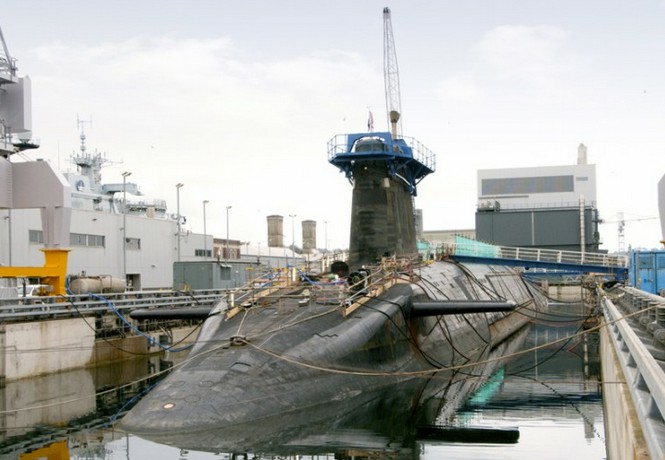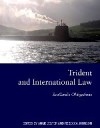Trident is a submarine-launched inter-continental ballistic nuclear weapons system, which is currently carried by four Royal Navy Vanguard-class submarines. Trident is a US nuclear system. The US provides assistance to Britain with its nuclear programme under the 1958 US-UK Mutual Defence Agreement.
The UK has access to 58 missiles from the US pool of Trident II D5 missiles. British Trident Submarines collect the missiles from the US Trident base at Kings Bay, Georgia in the South-East of the United States. While the submarines are in the United States, they will usually test fire one or two missiles at the US Eastern Test Range, off the coast of Florida, where the US test fires its Trident missiles. The Trident missiles are maintained and serviced in the United States.
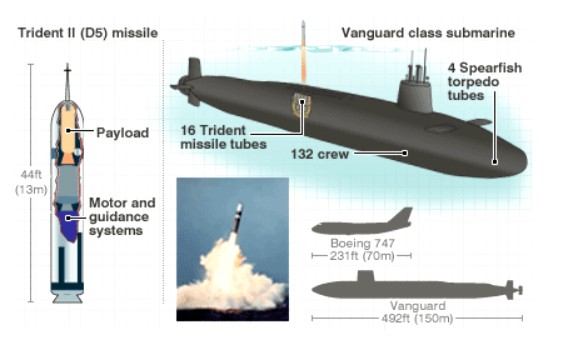
The Missiles
The Trident II D5, currently in service, is supplied by the Lockheed Martin Corporation. It is a three stage, solid-fuel missile, 13 metres long, more than two metres in diameter and weighs more than 60 tonnes. Each missile can carry up to 12 nuclear warheads and each Vanguard-class submarine can carry up to 16 missiles.

The missiles are carried in vertical tubes in the mid section of the submarine and are fired from beneath the surface. Each missile is independently controlled by the submarine. Precise data concerning target location is fed to the missile by the submarine’s strategic weapons system computers, together with information on the vessel’s position, course and speed, determined by an inertial navigation system.
When fired, a missile is ejected from the submarine by high pressure gas and only when it breaks the surface does the first rocket stage actually fire. Then the missile’s own inertial guidance system takes over, calculating actual flight behaviour and guiding it to a pre-determined point in space. After the third rocket motor has separated, the warhead carrier, known as the ‘bus’ takes a star sighting to confirm the missile’s position and then manoeuvres to the point at which the warheads can be released to ‘free-fall’ on to their selected target trajectories.
The Submarines
From 1994 the Royal Navy’s Vanguard-class submarines, equipped with the Trident weapons system, succeeded the Polaris missile boats which had maintained a continuous strategic nuclear deterrent for the United Kingdom for almost 30 years.
The current Trident submarines are giant vessels, 150 metres in length and displacing 16,000 tonnes when submerged. In spite of their huge size, they are among the quietest submarines in the world and are extremely difficult to detect.
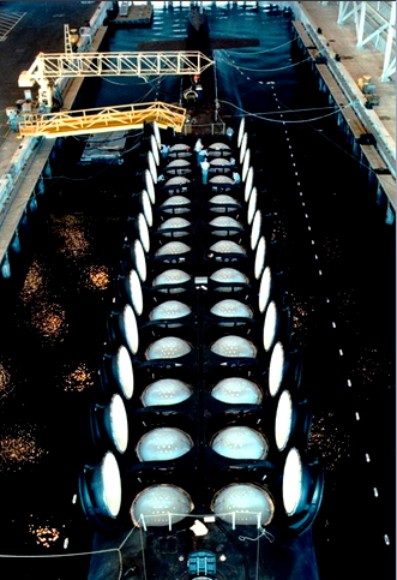
US Trident submarine with missile tubes open. A UK Trident sub has 16 missile tubes. The US version has 24
The submarines’ nuclear reactors produce enough power to supply a small town and need to be refueled only after years of operation. The boats produce their own oxygen and fresh water and this enables them to remain at sea almost indefinitely. They can circumnavigate the world underwater if necessary, and patrols lasting several months are routine.
The ‘Initial Gate’ decision to begin procuring parts for the new submarines was made in May 2011. However, the ‘Main Gate’ decision – whether to proceed with a Trident replacement – will be made in 2016, after the 2015 general election. Despite a decision not supposedly having yet been made on replacing Trident a £1.1bn contract to produce new reactor cores for the next generation of the UK’s nuclear-armed submarines has already been awarded to Rolls-Royce.
Trident submarines recently underwent major refits at Devonport Dockyard. The submarines, named Vanguard, Victorious, Vigilant and Vengeance are nuclear powered. During the refits the nuclear reactors were refuelled and new reactor cores fitted. The old reactor core and spent fuel rods (all highly radioactive) are then transported to be stored at Sellafield.
Rolls Royce in Derby design and produce the reactors and reactor cores for these and Britain’s other nuclear powered submarines which also undergo refit at Devonport. During refit, the radioactive coolant water from the submarine’s reactor is allowed to be discharged into the local river, the River Tamar.


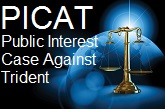









 Nuclear weapons crime in the UK has been reported to Thames Valley Police.
Nuclear weapons crime in the UK has been reported to Thames Valley Police.


